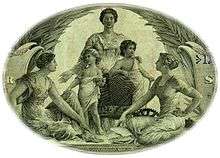American Renaissance


In the history of American architecture and the arts, the American Renaissance was the period from 1876 to 1917[1] characterized by renewed national self-confidence and a feeling that the United States was the heir to Greek democracy, Roman law, and Renaissance humanism. The American preoccupation with national identity (or New Nationalism) in this period was expressed by modernism and technology as well as academic classicism. It expressed its self-confidence in new technologies, such as the wire cables of the Brooklyn Bridge in New York. It found its cultural outlets in both Prairie School houses and in Beaux-Arts architecture and sculpture, in the "City Beautiful" movement, and "also the creation of the American empire.".[2] Americans felt that their civilization was uniquely the modern heir, and that it had come of age. Politically and economically, this era coincides with the Gilded Age and the New Imperialism.
The classical architecture of the World's Columbian Exposition in Chicago, 1893, was a demonstration that impressed Henry Adams, who wrote that people "would some day talk about Hunt and Richardson, La Farge and Saint-Gaudens, Burnham and McKim and Stanford White when their politicians and millionaires were quite forgotten." (The Education of Henry Adams [3]).
In the dome of the reading room at the new Library of Congress, Edwin Blashfield's murals were on the given theme, The Progress of Civilization.
The exhibition American Renaissance: 1876–1917 at the Brooklyn Museum, 1979, encouraged the revival of interest in this movement.
Notes
- ↑ Wilson, Richard Guy, ‘’The American Renaissance: 1876–1917’’, The Brooklyn Museum 1979
- ↑ Wilson, Richard Guy, ‘’The American Renaissance: 1876–1917’’, The Brooklyn Museum 1979 p. 15
- ↑ http://www.classicreader.com/Adams_Henry/Education_of_Henry_Adams/23.html
References
- Howard Mumford Jones, "The Renaissance and American origins," Ideas in America 1945.
- Richard Guy Wilson, "The great civilization", forward essay to The American Renaissance 1876–1917. Exhibition catalogue, The Brooklyn Museum, 1979–1980.
- Henry Hope Reed, The Golden City, (New York: Norton Library) 1971, Ch. 3:"The American contribution" pp 62–98.
| ||||||||||||||||||||||||||||||||||||||||||||||||||||||||||
| ||||||||||||||||||||||||||||||